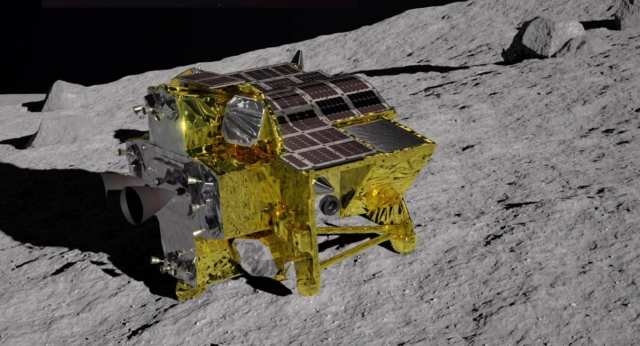The automatic interplanetary station SLIM landed on January 19 — Japan became the fifth country to make a soft landing on the surface of a natural satellite of the Earth. However, the joy was short-lived. The probe's solar panels did not generate energy, so the SLIM functioned for less than three hours, powered by a battery, then it was turned off. The Japanese Space Agency has summarized the preliminary results of the mission: partial success has been achieved, there is hope for full success. We just need to wait for the end of January.
First, the most unpleasant news. A full preliminary report on the landing, the condition of the lander and the results of the telemetry analysis will be ready no earlier than January 25. On this day, the Japan Aerospace Exploration Agency (JAXA) plans to hold a full-fledged press conference. At the same time, the public is promised to show the first images taken on the surface of the Moon. Yes, apparently, they are there, the ground services have received them, but they have not yet reported which cameras managed to complete their task.
Most of the information known today about the fate of the "Smart Lander for Lunar Exploration" (as the abbreviation SLIM stands for) was collected by the SpaceNews portal. Here are the facts that there is no doubt about:
- The probe landed in the area of the small crater Shiori (Shioli) on Friday, January 19, at 15:20 Coordinated Universal Time (18:20 Moscow time);
- A few seconds before landing, the spacecraft released two miniature lunar rovers — Lunar Excursion Vehicle (LEV) 1 and 2;
- After touching and the first communication session, it became obvious that SLIM was not powered by solar panels;
- The mission team decided to unload all possible data from the probe before its batteries run out below the safe threshold;
- Less than three hours later, at 17:57 UTC, the battery level dropped to 12 percent, and in order to prevent a deep discharge, the device was turned off.
The further efficiency of the mission is questionable. Presumably, the orientation of the dead AMC is such that there is simply not enough light on the solar panels. This may indicate that the automation made a mistake when lowering or the device fell on its side due to an unsuccessful design of the supports. More complete information is not yet available, so we can only speculate and wait.
And there is something to wait for: on January 31, the sun will rise over the Siori crater, and SLIM has every chance to get valuable energy. At least, the mission team at JAXA has high hopes for this scenario. Since the sun will rise from the opposite side, there is a possibility that enough light will fall on the solar panels to recharge the batteries. Regardless of whether the probe has fallen or is just standing on the wrong side of the star. The only thing that can interfere is if the device is lying directly on the solar panel, but the risk of such an outcome is small.
Note that even if SLIM does not "resurrect", it will no longer affect the success of the mission. We will find out how well the device performed its task in a few days — this information lies in the telemetry. The probe was supposed to demonstrate the technology of landing on the Moon with the highest accuracy: less than 100 meters of error. This skill is critically important for the further development of Selena, because future missions will have to land in difficult circumpolar terrain. The "plus or minus kilometer" option will not work there, it will lead to disaster.
The year 2024 did not start too well for lunar missions: SLIM is the second device in less than three weeks to experience serious problems during the flight to Selena. And if the Japanese probe at least reached its destination (although it is not entirely clear how accurately), then the American Peregrine probe did not fly further than near-Earth orbit.
At least two more launches are planned for the Earth's natural satellite in the coming months: the American private mission Intuitive Machines 1 in February and the Chinese Chang'e-6 in May. The latter should, for the first time, take soil from the far side of the Moon and deliver it to Earth.

